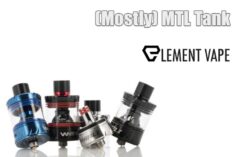Table of Contents [show]
Guo Altus T1 Coil-Less Tank Review
Comparing the new, redesigned Guo Altus T1 to the previous Altus V1 is like comparing the old iPhone 5 with the newer iPhone 6. The internals get an upgrade, systems get more efficient and the chassis gets slightly modified for a more enjoyable user experience. The CVU, or Central Vaping Unit technology was established in the first version of the Altus but criticisms and constructive feedback put the Owner and Head Engineer David Guo in motion to come up with a new, easier to use Coil-Less Atomizer; and the Guo Altus T1 ($79.77 Origin Vape) was born.
With most RDA, RTA and Sub-Ohm Tanks, finding a competing Atomizer to compare pros and cons with is a dime a dozen. With the Guo Altus T1, the only competition is the previous version of the Altus, which makes defining a great vape with this new type of technology difficult. Simply referring to usability and overall improvements, the Guo Altus T1 is ten times better this time around!
“Engineered, designed and optimized for performance in the USA” is the first line you’ll come across on the company website. The Guo Altus T1 Coil-Less CVU Tank, the sequel to the original Guo Altus V1, improves on most of the shortcomings creating a more user-friendly and enjoyable vaping experience. Customer feedback was taken greatly into account when creating the Altus T1, ensuring it’s easier to manage on a daily basis and does in fact outperform the Altus V1 ten-fold!
Altus T1 Specs
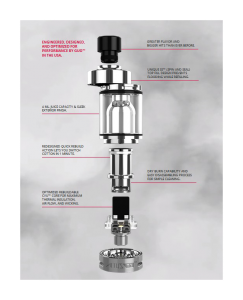
The Guo Altus T1 measures 22mm in diameter, one millimeter smaller than the first version but still managed to increase eJuice capacity to 4ml versus 3.5ml. Made from premium Stainless Steel and high quality glass, there are several areas that not only were vastly improved upon but are downright innovative. The Central Vaping Unit is thinner (0.76mm versus 1mm), lighter and by reducing the mass increases ramp up time by close to half of the previous Altus 2 to 3 second delay, while maximizing thermal insulation, wicking and airflow. The completely new SPS (Spin, Pull and Seal) top-fill system was engineered to prevent flooding or leaking when filling up the tank; a much needed revision over the complicated bottom filling Altus V1. While these systems work as intended, the overall experience is still not what I had expected or at the level of the more conventional Sub-Ohm Tanks.
The USA made, state-of-the-art CVU (Central Vaping Unit) core has a Ceramic composite heating element infused with conductive Tungsten material which ultimately creates a larger heating surface area for better performance. The CVU is comprised with some of the fastest thermo-conductive material in the world and capable of handling high temperatures of up to 2000°C (3600°F) in TC and Power Mode without causing major damage. The CVU makes connection from triple Gold-plated terminals was designed to last for years (yes that’s plural) but no long-term testing has confirmed the true longevity of the chip. Having the ability to dry burn the chip for easy cleaning and to extend the life of the CVU seems to be the evidence backing these promises. The several times I’ve taken apart, cleaned and rewicked the Guo Altus T1, the chip hasn’t yet had to be dry burned; simple soap, water and a paper towel does wonders.
The T1 at a Glance – Tom McBride
The Guo Altus T1 is definitely an expert level RTA. If you’re not ready to put in the work to maximize the potential of the T1, I’d recommend passing on the entire Coil-less technology. This tank is certainly not for everyone.
It works in TC mode, but only on YiHi-based chipsets, not with Evolv’s DNA boards. On other chipsets from Joyetech, et al., it can work but with no defined TCR it is hit and miss.
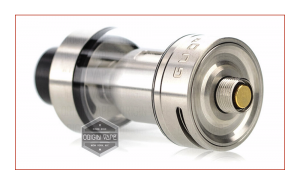
When used in Power mode (wattage), you will want to make sure that the mod you use doesn’t calculate the resistance in real time, like the Evolv DNA200, because it will overheat the CVU, as well as the tank itself. A nice and steady 50 to 60 watts is the best place to start, but at a resistance calculated when the T1 is cool to the touch. The CVU will heat up, and heat up to an optimal temperature when done properly.
Is Coil-Less Technology for You? – Julia
Most people that enjoy vaping do so with ease of use in mind. The easier it is to use; the more people will want to use it. That said, “easier” is in the mind of the vaper. After all, a cig-a-like is the easiest thing to use but does not satisfy most vapers. Moving to a box mod and a “tank” makes sense for real satisfaction. Coil-less technology is a whole ‘nother level.
You can’t just decide to pop over to Origin Vape and drop $80 on the Guo Altus T1, and when it arrives fill the tank and start vaping. Instead of a standard coil head, the T1 uses a chip as the heating element, with cotton carefully wrapped around it. While you can certainly get a nice vape going in wattage or TC mode, there are nuanced methods to get there.
In addition, if you vape with DNA mods you won’t get anywhere near the vape experience you’ll want. The tank was more or less built to work in TC mode with mods using the YiHi chips. Once you learn the ins and outs of the tank, the vape experience can be splendid.
Altus T1 Top Fill System

The SPS (Spin, Pull and Seal) top-fill system makes filling your 4ml of eJuice effortless and does a great job preventing the chamber that houses the chip and cotton from flooding. Simply close the airflow, spin the top cap, which is spring loaded and will pop up then twist it revealing a small silicone fill slot. By doing these three steps, the system closes off airflow from underneath and the top of the chimney creating internal pressure eliminating any chance of leaking. So far I’ve had zero issues but if you forget to close the bottom airflow first, you will get some bad flooding (did this purposely for testing purposes). The spring that pops the top cap up feels a bit flimsy and if the spring were to wear down or break, there are no replacements included or anyway to exchange it out. Unless the unicorn bottle you use has a long spout, the bottle hits the top cap forcing the bottle at an angle which makes filling difficult sometimes. The fill hole is also very small so cramming a dropper in it is tough but doable.
Altus T1 Airflow
The dual adjustable 12.8mm x 1.6mm airflow slots provide plenty of airflow and are a huge upgrade from the quad, almost impossible to turn airflow ring from the previous version. The beautiful engravings on the airflow ring are a nice touch and function as knurling to make adjusting the airflow easier. The internal barrel that houses the CVU chip has dual 9mm x 3.5mm cotton wicking slots that with the right PG/VG eJuice, is plenty of cotton to keep the chip saturated. The 8.5mm ID Delrin drip tip is held on by a single O-ring and gets vapor fed from the 5.9mm wide chimney. The top of the drip tip has a brownish color serving no advantages other than mismatching with the rest of the tank. Why not make it Black to match the O-rings?
Altus T1 Wicking
One of the biggest changes made to the Guo Altus T1 is the way it’s wicked. On the previous version, having to remove the base, loosen the lock ring, pull the CVU housing out, remove the O-ring and the list goes on and on. Not only was it a hassle but I dreaded every time I needed to change out the cotton and really put distance between me and the CVU technology. Luckily, Guo got rid of the lock ring, O-ring and other unnecessary pieces.
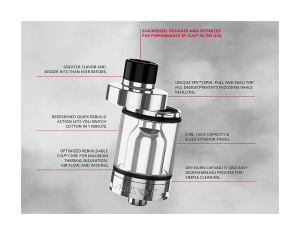
After removing the base of the Altus T1, you’re able to take the chip and internal barrel mechanism out quickly by gripping the two rubber ears, making the whole wicking process much simpler and in turn better performance oriented. Of course this method still has its flaws but is definitely a huge improvement over the Altus V1. Guo is advertising a cotton exchange of 3-minutes or less. It takes me closer to 10-minutes to get it set up properly, but with time that 10-minutes will surely come down.
When wicking the Altus T1, there’s a trial and error stage that might take a couple tanks to get your method working correctly. Now that I’ve wicked it several times the past week, finding the perfect amount of cotton to use while still getting a saturated vape comes as second nature.
The precut squares provided in the box, are bigger than you actually end up using. Try trimming a few millimeters off so when folding the cotton over the CVU chip, it doesn’t reach past the two rubber ears. Fold the cotton over and insert the tiny metal clip (I’ve thrown the clip away several times because it tends to blend in with the used cotton) which holds the cotton to the chip, making installing much easier. Then take the wicked CVU section and push it through the slits on the internal barrel. The edges are sharp toward the bottom so your cotton will get snagged from time to time but forcing the cotton up will work nine times out of ten. I line up my scissors with the ends of the rubber ears, cut and fluff the ends as much as possible. Do the opposite as you would with standard coils and over-prime the cotton surrounding the chip which gives you better flavor and the cotton lasts much longer.
Altus T1 Performance – Wattage Mode
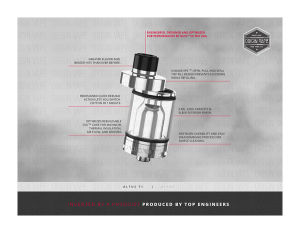
Performance is mediocre in VW Mode. At 50W, I’m winding up 7-8 second pulls! At 70W, after two strong rips my cotton is dry. I used the cotton that was preinstalled out of the box which needed some slight adjustments. I’d recommend just yanking the preinstalled cotton out and learning the new wicking method using the supplied cotton squares. They are fluffier, larger, and easy to work with; my experience improved dramatically just by changing the old cotton out. Peel off the outer layer, the ‘throw away layer’ is how I refer to it so your left with the fluffy goodness inside. Because of the large CVU surface area, keeping the cotton saturated is the biggest problem for me. The first pull or two provides good flavor but then instantly I get that lovely burnt dry cotton taste. The tank still gets very hot top to bottom; uncomfortably hot! The ramp up time is definitely an improvement over the first go round but is still over one second, sometimes more. The CVU reads right at 0.51Ω but as it heats up will reach as high as 0.93Ω. This is normal so if you notice such a large fluctuation, no need to worry.
Julia: Although I own a few mods that use the YiHi chipset I usually pick up a DNA mod or other type of TC tech. In fact, when it comes to vaping for my own pleasure I steer away from Temperature Control altogether. I prefer wattage vaping with Kanthal and Ceramic coils. Evaluating the claim for fantastic flavor I spent most of my time with the Altus T1 using Council of Vapor Tempest and the YiHi SX Mini (which I had to dig out of my collection).
Tom suggested vaping at no more than 50W, and he turned out to be correct. Any higher and the possibility of dry hits went up. The Altus T1 performs better with a 50:50 PG/VG eliquid as well.
What I truly like about the Altus T1 is how it uses less eliquid than the high-performance tanks I’ve been using exclusively. The flavor and vapor is best with lower wattage levels as well. I enjoyed using the T1 at 38-40W more than any other setting, the vape experience was pleasant, the flavor was excellent, and the vapor was better than I expected. There is also a more forceful throat hit, even with .3% nicotine.
Altus T1 Temperature Mode
Running the Guo Altus T1 in Temperature Control yielded an improved vape over VW but still slightly short of my expectations. I searched everywhere for a TCR (Temperature Coefficient of Resistance) and came up empty handed.
Starting with the Tungsten TCR of 0.00450, at 450°F (don’t exceed 480°F or it could release toxins according to Guo), I was able to adjust those numbers a bit to dial in a preferable number that felt accurate according to my style of vaping. Right around 0.00400, my temperature felt dead on and with the ‘Hard’ ramp-up setting on my SMOK X Cube Ultra, I was getting a pleasantly good vape!
Again, this is by no means a completely accurate TCR but at least is a good starting point if you’re interested. Hopefully, a solid TCR value will be worked out at some point for vapers wishing to take advantage of temperature controlled vaping.
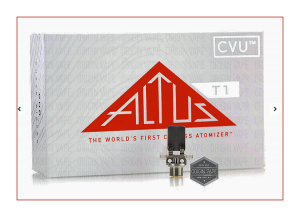
Is the Guo Altus T1 as good as other Sub-Ohm Tanks like the SMOK TFV8 or Freemax Starre Pure when it comes to flavor and vapor? Absolutely not, but I can tell you it’s an astronomical step in the right direction for CVU technology and it’s nice to see positive improvements made with the Altus T1. The entire tank still gets scorching hot with higher wattage vaping, so chain vaping is out of the question in the higher wattage range. Taking a good pull or two and resting the tank for a minute, the tank cools down surprisingly fast but definitely isn’t my preferred style; I’m a relentless, aggressive vaper some of my friends tell me.
The claim of the cleanest, purest flavor is somewhat misleading, if you ask me. I spent months (on and off) with the Altus V1 so I’m familiar with the Coil-Less technology and how to wick, prime and vape it properly.
The ratio of PG/VG makes a big difference when it comes to vaping with the CVU. Vaping a thicker, 80/20 or MAX VG juice, my cotton was drying out fast and I was getting more of a burnt taste. With a 50/50 PG/VG, the less viscosity made a huge difference in TC Mode and it was wicking efficiently and kept up to my back to back pulls.
Altus T1 Value
Is the Guo Altus T1 Coil-Less CVU Tank worth the high price tag? If you’re the type of person that has to have the new iPhone, new PlayStation, new everything on release day just because cutting edge technology is a passion, then the Altus T1 might tickle your fancy. It’s pricey but the technology is improving and will continue to advance in the near future.
Tom: Fortunately for me, I get access to a lot of gear. The Altus T1 didn’t cost me a penny, much less the $79.99 selling price. But, even if I had not been given one for review I would have spent the money to get one, as I did with the original model. I love being on the edge of all kinds of technology, I always have. I upgrade my computer when a new model comes out, I upgrade my iPhone (just got the iPhone 7 actually), and I even ordered the new Xbox S (with Gears of War 4). So hearing about a much better coil-less tank from Guo Vape, I was ready to plunk down the money.
Julia: Between writing and reviewing for Spinfuel VAPE, and Kiera and I’s photography studio, I don’t have a lot of time to fuss with complicated atomizers. Probably one of the reasons I learned to build coils and then never did it again. However, if I did have the time, I’d like to think that this new version of the coil-less atomizer would be something I would dive into. The only drawback for me is mixing the Altus T1 into my usual tank collection. Because it operates so differently from my other tanks I have no doubt that if I left the T1 alone for a couple of weeks and came back to it, it would require a couple of hours to get back into the “coil-less mindset” that is required.
Tom: Considering the price tag of the new Altus T1, $79.99, it is an expensive tank, though much less expensive than the first model. Future models will undoubtedly become even cheaper as the technology gets better.
Since the Altus T1 is considered an expert level RTA, I suspect that those interested in buying the tank will have a good understanding of what this coil-less tech is and how to get the most out of it. It is for that reason that I say the value is there for the expert level vaper, but not for those that are looking for an experience similar to the SMOK TFV8.
Julia: Considering the technology that went into this tank, you can’t judge the value without determining who will use it. For vapers that use mainstream tanks from Kanger or Aspire, the T1 is far too complicated. For advanced vapers looking for a flavor tank that will last years, and can be enjoyed in TC or Wattage modes under 50W, then the T1 is definitely worth giving a try.
The Altus T1 takes some time to set up and tweak, but there are many advantages to this coil-less technology that seemed to me to be worth learning about.
Yes, at $79.99 the Altus T1 is expensive, but the saving in coil heads and eliquid consumption will quickly pay for that extra $40 you’ll spend. But, again, the T1 is not an impulse buy tank. Hopefully this review will give you a basic understanding of the technology and help you decide if going down this road is worth it.
If you didn’t own the Altus V1, then this one will get you started on the right foot without all the stresses and hiccups with the first attempt. If you’re not familiar with Temperature Control vaping, I’d take a pass on it since Power Mode didn’t produce even close to the kind of vapor and flavor I was receiving in TC Mode. Plus, you get a One-Year Warranty so Guo does have your back.
Final Grade – C – Mike
Final Grade – B – Tom
Final Grade – B – Julia
“If you have the $79.99 to spend over at Origin Vape, you could get some enjoyment out of the Guo Altus T1. I personally love the challenge of chasing that perfect vape with new, innovative technology. Is there better flavor and cloud chasing tanks out in the market? Yes, but sometimes you can’t discard a product until you try it for yourself.” – Team Spinfuel





